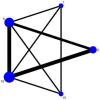The Effects of Sterilization Procedures on the Cutting Efficiency of Endodontic Instruments: A Systematic Review and Network Meta-Analysis
- PMID: 33810097
- PMCID: PMC8004799
- DOI: 10.3390/ma14061559
The Effects of Sterilization Procedures on the Cutting Efficiency of Endodontic Instruments: A Systematic Review and Network Meta-Analysis
Abstract
Sterilization processes guarantee the sterility of dental instruments but can negatively affect instrument features by altering their physical and mechanical properties. The endodontic instrumentation can undergo a series of alterations, ranging from corrosion to variation in the cutting angle and then changes in the torsional properties and torsional fatigue resistance. This systematic literature review and meta-analysis aims to investigate alterations to the cutting efficiency of endodontic instruments that are induced by procedures for their disinfection and sterilization. Methodologies adopted for this investigation follow the PRISMA (Preferred Reporting Items for Systematic Reviews and Meta-Analysis) guidelines. The following were used as search terms on PubMed and Scopus: "endodontic sterilization", "endodontic autoclave", "cyclic fatigue", "torsional", "cutting efficiency", "sterilization", "surface characteristics", and "corrosion". At the end of the selection process, 36 articles were identified, and seven of them are included in this systematic review. The results of a meta-analysis conducted for the use of 10 autoclaving cycles shows a standardized mean difference (SMD) of 0.80 with a p-value equal to 0.04 with respect to effect on cutting efficiency. The network meta-analysis, through direct and indirect comparison between the different autoclave cycles (0, 1, 5, 10, and 15 cycles), revealed that treatment involving 15 autoclave cycles produced the most robust results in terms of having the greatest effects in terms of altered cutting efficiency with a probability of 57.7% and a SUCRA (surface under the cumulative ranking) of 80%. The alterations in the effects on cutting efficiency appear to be triggered after five cycles of sterilization by heat (autoclave). In conclusion, the meta-analysis of the data indicates that the autoclave sterilization protocol must not be repeated more than five times to preserve cutting efficiency. Within the limitations of this review, we can therefore establish that sterilization by autoclaving alone results in steel and NiTi instruments becoming less efficient in cutting after five cycles, as measured by a reduction in cutting efficiency.
Keywords: autoclave; cutting efficiency; endodontic; mechanical property; network meta-analysis; sterilization.
Conflict of interest statement
The authors declare no conflict of interest.
Figures







Similar articles
-
Influence of sterilization procedures on the physical and mechanical properties of rotating endodontic instruments: a systematic review and network meta-analysis.Front Biosci (Landmark Ed). 2021 Dec 30;26(12):1697-1713. doi: 10.52586/5062. Front Biosci (Landmark Ed). 2021. PMID: 34994183
-
Effects of Hot Sterilization on Torsional Properties of Endodontic Instruments: Systematic Review with Meta-Analysis.Materials (Basel). 2019 Jul 8;12(13):2190. doi: 10.3390/ma12132190. Materials (Basel). 2019. PMID: 31288384 Free PMC article. Review.
-
[The influence of autoclave sterilization on surface characteristics and cyclic fatigue resistance of 3 nickel-titanium rotary instruments].Shanghai Kou Qiang Yi Xue. 2015 Dec;24(6):690-5. Shanghai Kou Qiang Yi Xue. 2015. PMID: 27063120 Chinese.
-
Influence of autoclave sterilization procedures on the cyclic fatigue resistance of heat-treated nickel-titanium instruments: a systematic review.Restor Dent Endod. 2020 Mar 31;45(2):e25. doi: 10.5395/rde.2020.45.e25. eCollection 2020 May. Restor Dent Endod. 2020. PMID: 32483542 Free PMC article.
-
Effect of repeated sterilization and ultrasonic cleaning on curet blades.J Dent Hyg. 1995 Jan-Feb;69(1):31-9. J Dent Hyg. 1995. PMID: 8632200
Cited by
-
Quantitative Evaluation of Debris Removal from NiTi Rotary Endodontic Instruments After Different Cleaning Procedures.Dent J (Basel). 2025 Jan 23;13(2):49. doi: 10.3390/dj13020049. Dent J (Basel). 2025. PMID: 39996923 Free PMC article.
-
Presence and Causes of Sterilization Equipment Failures with Biological Indicators in Dental Offices in Mexico: A Longitudinal Cohort.Medicina (Kaunas). 2024 Sep 19;60(9):1525. doi: 10.3390/medicina60091525. Medicina (Kaunas). 2024. PMID: 39336566 Free PMC article.
-
Cyclic Fatigue of Different Ni-Ti Endodontic Rotary File Alloys: A Comprehensive Review.Bioengineering (Basel). 2024 May 16;11(5):499. doi: 10.3390/bioengineering11050499. Bioengineering (Basel). 2024. PMID: 38790365 Free PMC article. Review.
-
Sterilization of New Endodontic Hand Files Stored in Dental Office Inventory: An In Vitro Study.Cureus. 2023 Mar 14;15(3):e36116. doi: 10.7759/cureus.36116. eCollection 2023 Mar. Cureus. 2023. PMID: 37065374 Free PMC article.
-
Cytocompatibility of titanium and poly(etheretherketone) surfaces after O2 non-thermal plasma sterilization.PLoS One. 2023 Aug 30;18(8):e0290820. doi: 10.1371/journal.pone.0290820. eCollection 2023. PLoS One. 2023. PMID: 37647324 Free PMC article.
References
-
- Dioguardi M., Sovereto D., Illuzzi G., Laneve E., Raddato B., Arena C., Caponio V.C.A., Caloro G.A., Zhurakivska K., Troiano G., et al. Management of Instrument Sterilization Workflow in Endodontics: A Systematic Review and Meta-Analysis. Int. J. Dent. 2020;2020:1–20. doi: 10.1155/2020/5824369. - DOI - PMC - PubMed
Publication types
LinkOut - more resources
Full Text Sources
Other Literature Sources

